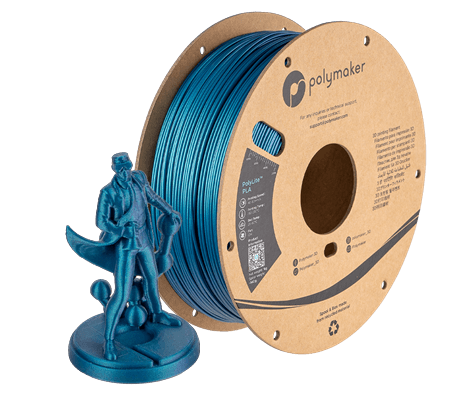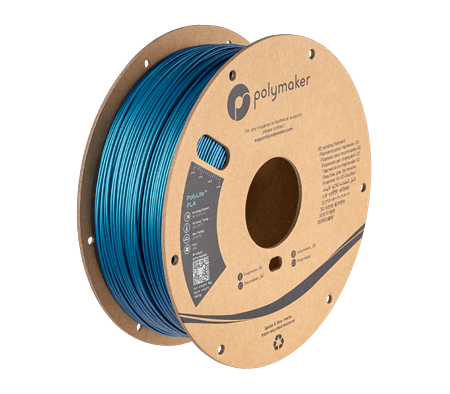Polymaker PolyLite™ PLA Starlight-series is a collection of high quality PLA filaments each with a unique glittery iridescent sheen.
PolyLite™ Starlight PLA is a series of high quality PLA filaments with iridescent pigments that reflect colours differently depending on the position of light. Each colour has been formulated to deliver an out-of-this-world effect combining a glittery, shimmery and iridescent surface finish.
-
Shimmery & Iridescent Effect - PolyLite™ Starlight PLA is a high quality PLA with a colour changing pigment that reflects different colours depending on the angle of light. Combined with a glittery and shimmery surface finish that helps to hide the layer lines; Starlight PLA is an excellent choice for stunning cosplay props, articulated models, puzzles, astronomy models, science fiction toys, figurines and a wide range of fun and aesthetically pleasing projects.
-
Strength and Rigidity - PolyLite™ Starlight PLA is based on the same high molecular weight PLA as PolyLite™ PLA which makes it one of the most rigid PLA materials on the market. The combination of good tensile strength, inter-layer adhesion and stiffness makes PolyLite™ Starlight PLA ideal for product design and prototyping applications that require a rigid material that is easy to print.
-
Compatibility In Mind - PolyLite™ Starlight PLA is compatible with a wide range of 3D printers and works well on most printing surface with a thin layer of glue stick applied, no heated bed is required but can sometimes be used at 40 - 60°C for better results (maximum 60°C).
-
Jam-Free™ Technology - PolyLite™ Starlight PLA is manufactured with Polymakers Jam-Free™ technology which improves the heat stability of the filament with softening temperatures over 140°C and leads to excellent printing quality with zero risk of nozzle jams caused by heat creep [1].
-
Uncompromised Quality - PolyLite™ Starlight PLA filament is made with the highest quality ingredients including Ingeo® from Natureworks. Natureworks is a world-leading biopolymers supplier based in the USA with a portfolio of high quality raw PLA materials produced from rapidly renewable plant resources. Combining Polymakers innovative R&D technologies, compounding and extrusion systems with Natureworks Ingeo® resins produces a reliable 3D printing filament to print beautiful and accurate models
[1] Heat creep is the the process of heat spreading irregularly throughout the hot end, one common example is with all metal hot end designs. Once heat creeps towards the cold end, the PLA filament softens prematurely in the cold end and expands resulting in a jam. Polymakers Jam-Free™ technology increases the heat resistance of the filament itself (not the printed part) to 140˚C which prevents the filament from prematurely softening in the cold end and can still melt rapidly once entering the heating zone.
Printing Settings
| Nozzle Temperature |
190°C - 230°C |
| Build Plate Temperature |
25°C - 60°C |
| Build Surface Material |
Works well with most build surfaces i.e Glass, Blue Tape, BuildTak® etc |
| Build Surface Treatment |
Can apply Magigoo Original or PVA glue to the build surface to improve adhesion. |
| Cooling Fan |
ON |
| Printing Speed |
40 mm/s - 60 mm/s |
| Recommended Support Material |
Single Extrusion:
Self Support
Dual Extrusion:
PolyDissolve™ S1 (Dissolve in tap water)
PolySupport™ (Easy break-away support material)
|
The above are printing recommendations based on 0.4 mm nozzle. Please note ideal printing conditions may vary depending on your 3D printer setup. For high speed 3D printers, make sure to increase your extrusion temperature in order to use higher printing speeds.This material features a fine glitter powder, using smaller sized nozzles should be considered experimental.
For other tips printing PolyLite™ Starlight PLA contact us!
Specification
| Net Weight |
1kg |
| Material Type |
Starlight PLA |
| Density |
1.17 (g/cm3 at 21.5˚C) |
Compatibility
PolyLite™ Starlight PLA has been engineered with compatibility in mind to print excellently on a wide range of 3D printers. The Jam-Free™ technology implemented into PolyLite™ PLA can improve compatibility with all metal hot end designs that suffer from heat creep.
High rigidity materials like PolyLite™ Starlight PLA work best in set ups where the filament guide system is smooth and as no harsh bends.
Of course with thousands of unique 3d printer models on the market, we can't guarantee each filament type will work with every 3D printer. Slicer experience and setting adjustment is always required to get the most out of a material. Before jumping into an ambitious project we always recommend printing some known calibration tests to build or make adjustments to the filament profile.
Technical Data
All testing specimens were printed under the following conditions: Nozzle Temperature = 205˚C, build plate temperature = 45˚C, infil = 100%, cooling fan = ON
All specimens were conditioned at room temperature for 24h prior to testing.
THERMAL PROPERTIES
| |
Value |
Testing Method |
| Glass Transition |
61°C |
DSC, 10°C/min |
| Heat Deflection Temperature |
0.45MPa - 59.8°C
1.8 MPa - 58.1 °C
HDT Curve
|
ISO 75 |
| Vicat Softening Temperature |
62.9°C |
ISO 306, GB/T 1633 |
MECHANICAL PROPERTIES
| |
Value |
Testing Method |
Youngs Modulus
(X-Y) |
2636 ± 330 MPa |
ISO 527, GB/T 1040 |
Tensile Strength
(X-Y) |
46.6 ± 0.9 MPa |
ISO 527, GB/T 1040 |
Bending Strength
(X-Y) |
85.1 ± 2.9 MPa |
ISO 178, GB/T 9341 |
Charpy Impact Strength
(X-Y) |
2.68 ± 0.16 kJ/m2 |
ISO 179, GB/T 9343 |
We have full MDS and technical data sheets for PolyLite™ PLA and all other Polymaker products. Contact us to enquire!
The typical values presented in Polymakers data sheet are intended for reference and comparison purposes only. Due to the nature of 3D printing they should not be used for design specifications or quality control purposes.
STORAGE & DRYING
All plastics are hygroscopic meaning they absorb moisture from the air which can affect printing quality and strength of printed parts. How quickly this absorption occurs depends on the material and your environment. Polymakers PolyLite™ PLA filaments are dried and packaged in a vacuum sealed bag with desiccant to ensure the best printing quality. When not in use PolyLite™ PLA should be stored away from sunlight and sealed in the packaged resealable bag.
Although filaments can be dried, drying will speed up the aging process of the plastic making it more brittle over time. Preventing the filament from absorbing moisture in the first place is the best solution to keep your filament working to its maximum potential. For long term storage we highly recommend storing in a sealed container with dry desiccant that reduces the relative humidity to 10-20% RH.
In-house we manage our filaments with Polymakers PolyDryer™ which keep offers best-in-class sealing to protect filaments from absorbing moisture
If you hear popping sounds and notice that the surface quality of your print is uneven or the colour is not consistent, this is a likely indicator that the filament has absorbed too much moisture. Spools of PolyLite™ PLA can be dried with Polymaker PolyDryer™ using power level 1. Alternatively if you have a convection oven that is accurate at low temperatures, users can dry filament in a preheated convection oven at 55˚C for up to 6 hours. Results may vary depending on the accuracy of your oven so please be conservative. For more information about filament drying please read our user guide.
FAQ
Q: Is this a co-extrusion or dual colour PLA?
A: The Starlight series are not co-extruded however similar to how co-extrusion dual coloured PLA can print models with two contrasting or complimentary colours, the pigments in the Starlight-series PLA will reflect different colours depending on the angle of light.
Q: Does Jam-Free™ technology prevent all filament jamming?
A: Jam-Free™ technology is designed to prevent jamming caused by heat creep. There are many reasons why a material may jam, such as a partially blocked nozzle, printing with the wrong extruder temperature or incorrect nozzle height; Polymaker's Jam-Free™ technology won't prevent jamming in these cases.
Q: What support materials can I use with this product?
A: If your 3D printer supports multi-material 3D printing, PolyLite™ PLA is compatible with Polymaker’s PolySupport™ and PolyDissolve™ S1 filament. PolySupport™ is a breakaway support material which can be easily peeled away and PolyDissolve™ S1 is a water dissolvable support material, ideal for complex geometries.
Q: Should I rewind this filament if I want to use it with a different spool?
A: We strongly advise against tampering with the product by rewinding. See our article for full details about the risks. All Polymaker filaments are wound with tension but without strain. Rewinding completely rearranges the curvature of the winding and this strain over time can cause most plastics to catastrophically break. If for some reason your printer is locked into fitting less than standard sized spools, there may be safe printable adaptors or external mounting solutions available.
Don't know where to start? Or which filament will suit your application? We have a broad range of support options including telephone support. Contact us today!
|
Filament |
| Diameter |
1.75mm |
| Spool Weight |
1kg |
































